The Organization
The study is being carried out, using the Saudi Medical Journal as the hypothetical organization for which the survey is being conducted.
Nature of the Problem
The survey aims to analyze if there is any connection between consumption of fast food and obesity. Recent research into obesity statistics has shown that in the United States, more than fifty million people are overweight, out of which forty million are obese and around three million are highly obese (Anne Collins Weight Reduction Program). The research continues to claim that diseases such as Type II diabetes, cardiovascular disease, and breast and colon cancer are highly correlated to obesity.
There are many causes of obesity, such as lack of exercise, overeating, and genetic reasons. We aim to study the sole effect of fast food consumption on obesity.
Obesity is a disease – plain and simple. If the research supports our hypotheses that fast food consumption is indeed a cause of obesity, then we conclude that consumption of fast food items should be condemned or at least decreased in terms of quantity and frequency.
The problems that arise in this research are as follows:
- Most people do not perceive obesity as a cause for concern, or as a disease. Parents, especially mothers, worry about the fact that their children do not eat enough and are either weak or skinny. They proceed to feed their children with food that appeals to the children. This includes fast food items such as burgers, sandwiches and pizzas. The result is that children acquire a taste for fast food early in their lives.
- The research is limited by the fact that people, as already mentioned do not generally take the issue of obesity very seriously and hence this lack of seriousness is conveyed in most of the questionnaires.
Objective of the Study
The study aims to ascertain the relationship between fast food consumption and obesity. If, as we believe, there is a positive correlation, we will try and create awareness among the public by use of this report.
Formulation of Hypotheses
The hypotheses for our research are as follows:
- Fast food consumption is a factor in obesity
- People who are provided the awareness of the dual harmful effects of fast food and obesity will at least reduce consumption of fast food.
Questionnaire Design
The questionnaire uses direct questions aimed at getting information from the respondents about basic issues such as demographics, followed by questions on eating preferences, fast food consumption frequency and questions to judge the awareness of respondents about fast food and obesity.
Both open ended and close ended questions have been used. Where necessary, such as to judge awareness or obtain an opinion, open ended questions are applied. We have avoided using too many questions so that the interest of the respondents does not waiver.
Appendix 1 is available for the reader to see a copy of the sample questionnaire.
Sampling and Data Collection
The sample has been taken from a university campus. The average age of the sample respondents is twenty one. The respondents are mainly university students. Therefore, there might be a slight overstatement of the frequency of fast food consumption as most fast food consumers are young adults.
Questionnaires were printed and supplied to respondents on campus. Some questionnaires were sent via email to other education institutes which included schools as well as universities.
Results
The results are presented after thorough examination of the responses considering level of completion and seriousness of the respondent. There are a total of thirteen legitimate responses on which we base the analysis and result. Of the thirteen respondents, eighty five percent are single, where as fifteen percent are married.
Table 1
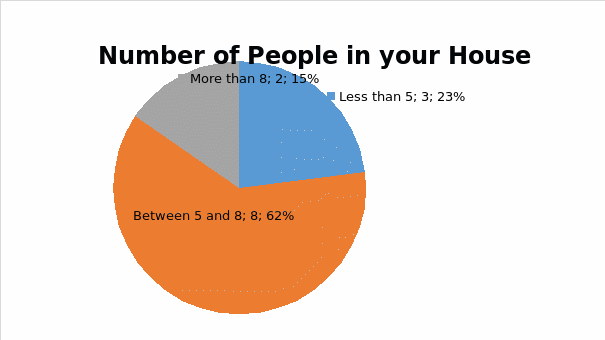
Analysis: Figure one shows that based on the sample, most of the people live in a house that consists of five to eight people. This information is supposed to alienate fast food’s impact on obesity from genetic reasons of obesity. This information, coupled with information presented later in this report will determine the cause of obesity.
Table 2
Analysis: Table 2 and Figure 2 reveal that, based on the sample, sixty two percent of the people in the population consume fast food daily and about thirty eight percent consume it at least once a month. None of the respondent checked the choices “monthly” or “never”. This shows us that consumption of fast food is relatively high among the population.
Table 3
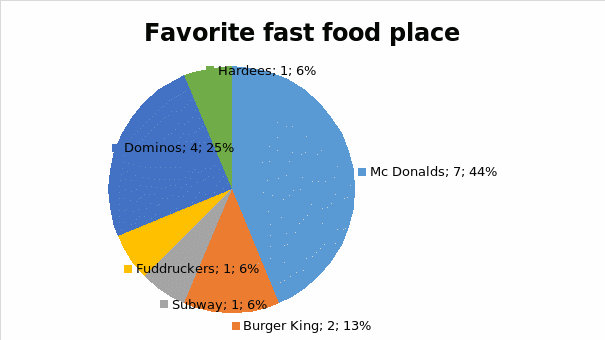
Analysis: The results show that among the preferred locations for fast food consumption, MacDonald’s is the leader with around forty four percent of the respondents checking MacDonald’s as their preferred fast food place. Dominos follows at number two with twenty five percent and Burger King ranks third with thirteen percent. This table pinpoints some of the leading fast food restaurants that might be providing food that is high in calorie content and might be a cause of obesity.
Table 4
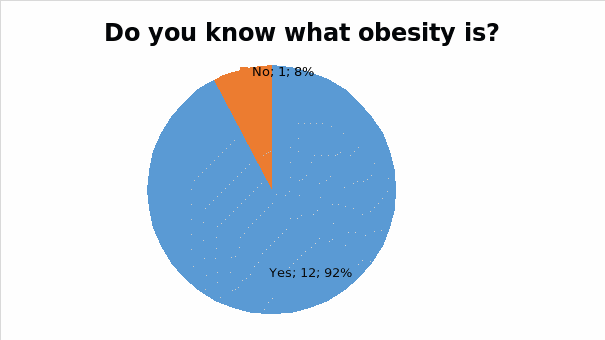
Analysis: Table 4 and the corresponding figure reveal that obesity is a concept that is known to most of the population. Ninety two percent of the population understands obesity and what it implies in general. This table along with the following Table 5 will provide an important conclusion later.
Table 5
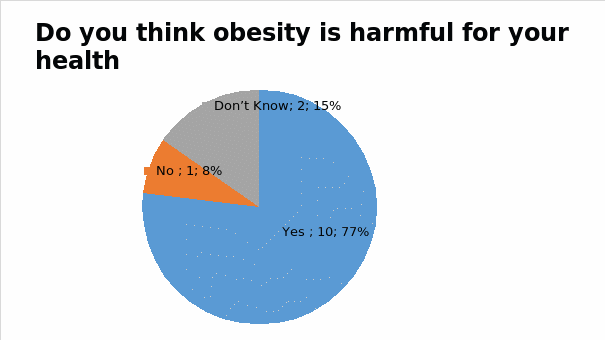
Analysis: Table 5 and the figure above show that a majority of the population hold the view that obesity is indeed harmful for the health of an individual. Seventy seven percent of the correspondents believe that obesity is definitely a factor of concern, and eight percent do not believe that is the case. Fifteen percent say that they do not know. Based on our research, we hope that the people who answered no or don’t know will answer in the affirmative after they have seen the research.
Table 6
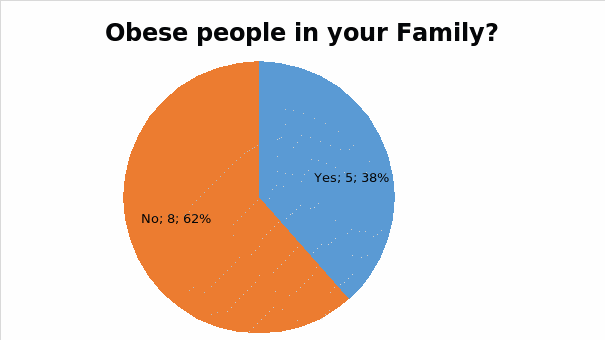
Analysis: The figure and the Table six show that of the total number of respondents, most do not come from obese families, so we can conclude that if the respondents are obese now or might be later, it will not be because of hereditary factors.
Table 7
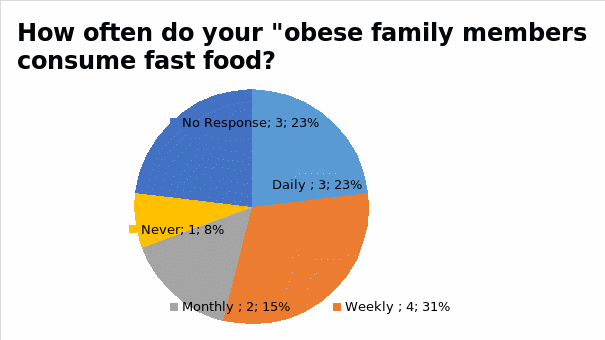
Analysis: This analysis has the purpose of showing that if there is obesity in the family of the population, a great deal of that extra weight has to do with eating habits rather than genetic deficiencies. As the table shows, More than fifty percent of the respondents have family members that are obese and consume fast food at least weekly if not daily. We have used deduction to determine that at least a few of the 23 percent of the respondents that answered “no response” might have done so due to the fact that they felt embarrassed about admitting to having obese family members.
Table 8
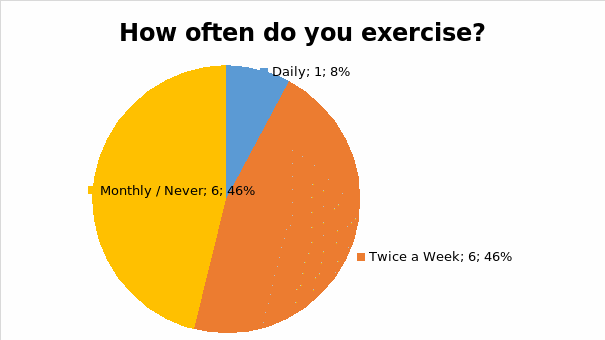
Analysis: By looking at the above table (Table 8) and the figure, we can see that of the sample population, at least fifty four percent of the people exercise at least twice a week, no respondent works out just once a week. Of the other respondents, they either do not exercise at all or do very seldom, which in our opinion does not count for any exercise.
Table 9

Analysis: Of the respondents only 8 percent believe that fast food is not unhealthy for consumption. A whopping 92 % agrees that fast food is indeed unhealthy for consumption on a regular basis.
Table 10
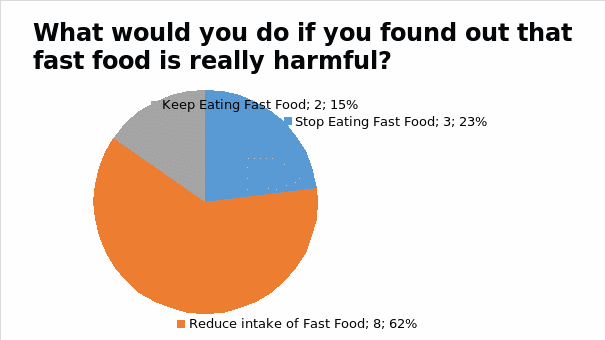
Analysis: The table 10 and the corresponding figure shows that if provided the evidence that fast food is indeed harmful for one’s health, based on the sample, at least 85 percent of the population would either stop eating fast food altogether or reduce the consumption of fast food whereas the rest claim that they would continue their intake of fast food as it currently stands.
Table 11
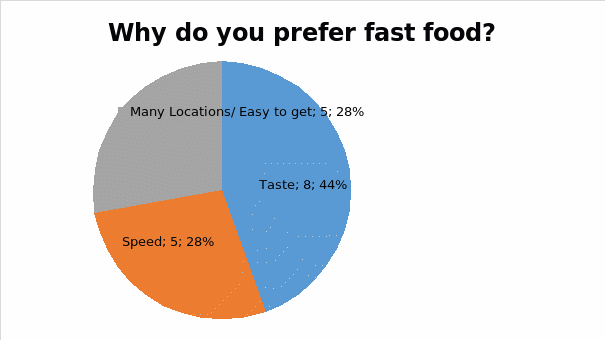
Analysis: Most of the people consume fast food based due to the three reasons mentioned above. This was designed as an open ended question and people were free to answer what in their minds was the main reason for fast food preference. Most answered that their main motivation behind the consumption of fast food was that they simply loved the taste. Second place was a tie between availability of fast food in many locations and the speed of service that one receives from fast food outlets.
Implications of the results found by the research
From the results of our research, we confirmed a lot of our opinions regarding fast food intake and obesity. One thing that we would like to mention is that an assumption of the research is that fast food is full of a high amount of calories and if eaten in significant proportions and quite frequently, it will indeed cause obesity. For example, Mc Donald’s Big Mac is over five hundred calories (Shape Fit). For more information on other fast food outlets, please view the Shape Fit website mentioned in the references section at the end of this report.
The research implications then are:
- Table 2 and Table 3 show that fast food and most of the respondents consume fast food regularly and that there is a positive link between fast food intake and some of the biggest names in fast food production such as McDonalds and Burger King.
- Table 6 and Table 7 show that of the sample population that has obese family members; most of those family members consume fast food regularly.
- Table 8 shows that at least 50 percent of the sample population is exercising at least twice a week and therefore obesity can not be due to lack of activity.
- More than 90 percent believe that fast food is unhealthy and still consume fast food regularly.
- More than 80 percent of the respondents have confirmed that they will reduce consumption of the fast food if presented with actual evidence of how harmful it is.
- Most prefer fast food because of taste, convenience and speed of service
Conclusion
We conclude that based on our limited research, both our hypotheses that:
- Fast food does play a role in obesity and
- The hypotheses that if provided awareness about the harm of fast food is provided to the people, people will reduce fast food consumption are valid.
Therefore, if awareness is provided, less people will eat less amounts of fast food and hence obesity might be (at least in part) prevented.
For more information on fast food and its consequences, please view the excellent documentary Super Size Me” by Morgan Spurlock on YouTube.com.
Works Cited
Anne Collins Weight Reduction Program. Latest Obesity Statistics. 2007. Web.
Shape Fit. McDonalds Calories – Fast Food Nutrient Details! 2009. Web.
Yoshimoto, B. Kitchen. Grove Press, 2006.